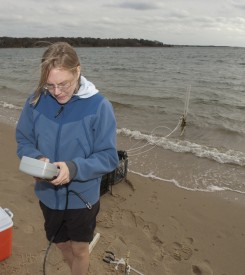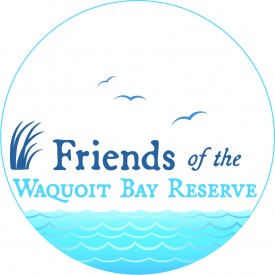Quantifying groundwater nutrient inputs and their impacts to Waquoit Bay estuaries
Project Title: Quantifying groundwater nutrient inputs and their impacts to Waquoit Bay estuaries
Duration: May-2024 to August-2024
Funding Source(s): Various educational programs at MBL, including the Logan Science Journalism Program, the NSFREU Biological Discovery in Woods Hole Program, the University of Chicago Metcalf Summer Internship Program, and the Brown-MBL LINK Internship Program.
Principal Investigator info: Lead investigator: Javier Lloret, Marine Biological Laboratory, Email: jlloret@mbl.edu
Onsite-contact: Kelsey Chenoweth, Marine Biological Laboratory, Email: kchenoweth@mbl.edu
Project Description: Lloret, together with several groups of students, interns, and faculty from several educational programs at the Marine Biological Laboratory, will be developing projects aimed at understanding the effects of excess nutrient loadings on ground- and estuarine water quality, and their impacts on the food webs of the various Waquoit Bay estuaries. They will define links between nitrogen loads from shifting land use and atmospheric deposition for the region, groundwater nitrogen concentrations, and water quality indicators in selected receiving estuaries. They will examine how excessive nitrogen loads alter the composition and structure of estuarine food webs. Waquoit Bay’s range in nitrogen loads will serve as a wider context within which to place data from other local estuaries.
Evaluating innovative technologies to reduce the impact of septic system contaminants on ecological keystone species
Project Title: Evaluating innovative technologies to reduce the impact of septic system contaminants on ecological keystone species
Duration: 2/2024-2/2026
Funding Source: Woods Hole Sea Grant
Principal Investigator Lead Investigator / onsite-contact: Jed Goldstone, Woods Hole Oceanographic Institution
Project Description: Contaminants of Emerging Concerns (CECs) are a diverse class of compounds with widely varying toxicological and chemical properties, commonly associated with municipal wastewater, urban storm water, agricultural run-off, and other non-point sources, which makes them difficult to monitor and regulate. Important classes of CECs are pharmaceuticals, detected in more than 80% of streams, and in coastal waters, and endocrine disrupting compounds (EDCs). Septic system effluents are a suspected source of CECs to freshwater ponds, aquifers and drinking water supplies, and to coastal waters, because typical septic system designs do not provide much removal efficiency for most CECs. Innovative and alternative (IA) septic system systems designed for nitrogen remediation may provide significant co-benefit removal of CECs, particularly pharmaceuticals and EDCs.
Blue mussels (Mytilus edulis) and ribbed mussels (Geukensia demissa) are foundation species in the New England intertidal that establish and maintain the key habitats that provide essential ecosystem services. However, there is an observed decline of both species in New England (>60% loss of blue mussels since 1970). CECs and EDCs can have biological effects at very low exposure concentrations, have been detected in coastal waters and animal tissue, and may be impacting populations of blue and ribbed mussels. Our work has shown that M. edulis is highly sensitive to pharmaceutical exposures, particularly steroid-like EDCs, and we suggest that these effects extend to closely related Mytilidae species such as G. demissa. The proposed research will examine the effects of septic effluent and septic field leachate on M. edulis and G. demissa sex ratios, and directly test the ability of IA systems to reduce compounds that affect sex gene expression.
Impacts of tidal hydrology on maritime forest and coastal marsh dieback
Project Title: Impacts of tidal hydrology on maritime forest and coastal marsh dieback
Duration: July 2022 – Dec 2022 (continuation of July 2020-2021 project)
Funding Source(s): NSF, Geological Society of America Student Grant
Principal Investigator: Elizabeth Watson (Elizabeth.b.watson@gmail.com)
Onsite Contact: Andrew Payne (ap3752@drexel.edu)
Affiliation: Drexel University and the Academy of Natural Sciences
Project Description: This project will analyze groundwater patterns, salinity, and plant stress using mapping of near-infrared spectral indices, and plant photosynthesis measures to address knowledge gaps in our understanding of the impacts of sea level rise to maritime forests and salt marsh. We are focusing on understanding the proximate causes of marsh forest dieback by building robust and complementary geospatial datasets focusing on key hydrologic factors and plant stress indicators. This project also involves study sites in New Jersey and New York.
The impact of excess nutrients in Waquoit Bay estuaries
Project Title: The impact of excess nutrients in Waquoit Bay estuaries
Duration: April-2022 to December-2022
Funding Source(s): Various educational programs at MBL, including the Logan Science Journalism Program, the NSFREU Biological Discovery in Woods Hole Program, the University of Chicago Metcalf Summer Internship Program, the Brown-MBL LINK Internship Program, and the Semester in Environmental Science.
Principal Investigator and institutional affiliation
Lead Investigator: Javier Lloret
Affiliation: Marine Biological Laboratory
Project Description:
Dr. Lloret, together with several groups of students, interns, and faculty from several educational programs at the Marine Biological Laboratory, will be developing projects aimed at understanding the effects of excess nutrient loadings on ground- and estuarine water quality, and their impacts on the food webs of the various Waquoit Bay estuaries. They will define links between nitrogen loads from shifting land use and atmospheric deposition for the region, groundwater nitrogen concentrations, and water quality indicators in selected receiving estuaries. To achieve this goal, they will evaluate how changing climate drivers (increased rainfall, lowered nitrogen concentrations in deposition, and higher temperatures) alter timing and amount of nitrogen discharged from watersheds to receiving estuaries. They will also examine how excessive nitrogen loads alter the composition and structure of estuarine food webs. Waquoit Bay’s range in nitrogen loads will serve as a wider context within which to place data from other local estuaries.
Mercury loading in estuarine food webs in relation to nitrogen loading
Title: Mercury loading in estuarine food webs in relation to nitrogen loading
Duration: July 2011-October 2017
Funding Source: WHOI Sea Grant
Lead Investigator: John Logan
Affiliation: Massachusetts Division of Marine Fisheries
Contact: john.logan@mass.gov
Description: This project seeks to understand the relationship between eutrophication and mercury bioaccumulation in estuarine
food webs. Recent work has shown elevated mercury concentrations in groundwater entering estuaries in Cape Cod,
Massachusetts, possibly due to mobilization mediated by eutrophication. To assess the extent of mercury transfer from
groundwater to aquatic food webs and test the proposed relationship with eutrophication, we are sampling
representative estuarine biota from Waquoit Bay and three neighboring estuaries with different nitrogen loads. We plan
to relate mercury concentrations to nitrogen loading as well as trophic interactions using stable isotope tracers.
Effects of sea level rise on maritime forest dieback
Project Title: Effects of sea level rise on maritime forest dieback
Duration: July 2020-July 2021
Funding Source(s): NSF
Lead Investigator: Elizabeth Watson
Affiliation: Drexel University and the Academy of Natural Sciences
Email: elizabeth.b.watson@gmail.com
Project Description: This project will analyze groundwater patterns, salinity, and plant stress using mapping of near-infra spectral indices
to address knowledge gaps in our understanding of the impacts of sea level rise to maritime forests. We are focusing
on understanding the proximate causes of forest dieback by building robust and complementary geospatial datasets
focusing on key hydrologic factors and plant stress indicators. This project also involves study sites in New Jersey
and New York and aims to focus on identifying whether salinity or flooding thresholds exist in terms of driving
forest die-off as well as how local factors such as geology and sediment permeability alter these factors.
Groundwater controls on microbial communities in coastal aquifers
Project Title: Groundwater controls on microbial communities in coastal aquifers
Date: 6/2019-6/2020
Principal Investigator(s): Dr. James Heiss
Affiliations: UMass Lowell
Summary: Groundwater discharge from the seabed into coastal ecosystems carries nutrients and other chemicals that affect surface water quality and ecosystem health. Microbial processing of groundwater contaminants prior to discharge alters the chemistry of discharging groundwater and can be an important ecosystem service that reduces nutrient fluxes that would otherwise contribute to coastal eutrophication. The objective of this research is to understand how microbial communities process nutrients and other chemicals in coastal aquifers. The work will aid managers aiming to reduce nutrient loads to surface water bodies. Groundwater wells, water quality sensors, and porewater sampling will provide information into how groundwater hydrology affects microorganisms in the subsurface and nutrient fluxes in discharging groundwater.
Intertidal salt marshes as an important source of inorganic carbon to the coastal ocean
Project Title: Intertidal salt marshes as an important source of inorganic carbon to the coastal ocean. Limnology and Oceanography, 61(5), 1916-1931.
Date: 2016
Principal Investigators: Wang, Z. A., Kroeger, K. D., Ganju, N. K., Gonneea, M. E., & Chu, S. N.
Abstract: Dynamic tidal export of dissolved inorganic carbon (DIC) to the coastal ocean from highly productive intertidal marshes and its effects on seawater carbonate chemistry are thoroughly evaluated. The study uses a comprehensive approach by combining tidal water sampling of CO2 parameters across seasons, continuous in situ measurements of biogeochemically‐relevant parameters and water fluxes, with high‐resolution modeling in an intertidal salt marsh of the U.S. northeast region. Salt marshes can acidify and alkalize tidal water by injecting CO2 (DIC) and total alkalinity (TA). Read Full text: http://onlinelibrary.wiley.com/doi/10.1002/lno.10347/full
Contemporary Methods for Quantifying Submarine Groundwater Discharge to Coastal Areas
Project Title: Contemporary Methods for Quantifying Submarine Groundwater Discharge to Coastal Areas
Date: 2016
Principal Investigators: Ray, R. L., & Dogan, A.
Affiliations:
Summary: In Emerging Issues in Groundwater Resources (pp. 327-364). Springer International Publishing.
Submarine Groundwater Discharge (SGD), which represents subsurface exchange of water between land and ocean, is a major component of the hydrological cycle. Until the mid-1990s, it was generally believed that SGD rates were not large enough to influence ocean water budgets. Read full text… http://link.springer.com/chapter/10.1007/978-3-319-32008-3_12
Continuous measurements of dissolved Ne, Ar, Kr, and Xe ratios with a field-deployable gas equilibration mass spectrometer
Project Title: Continuous measurements of dissolved Ne, Ar, Kr, and Xe ratios with a field-deployable gas equilibration mass spectrometer
Date: 2016
Principal Investigators: Manning, C.C., Stanley, R.H., & Lott III, D.E. (2016)
Affiliations:
Abstract: Noble gases dissolved in natural waters are useful tracers for quantifying physical processes. Here, we describe a field-deployable gas equilibration mass spectrometer (GEMS) that provides continuous, real-time measurements of Ne, Ar, Kr, and Xe mole ratios in natural waters. Analytical chemistry, 88(6), 3040-3048. Read full text… http://pubs.acs.org/doi/abs/10.1021/acs.analchem.5b03102
Geochemistry of redox sensitive trace elements in a shallow subterranean estuary
Project Title: Geochemistry of redox sensitive trace elements in a shallow subterranean estuary
Date: 2015
Principal Investigator(s): O’Connor, A. E., Luek, J. L., McIntosh, H., & Beck, A. J.
Abstract: Submarine groundwater discharge (SGD) is an important component of chemical fluxes in the coastal ocean. The composition of SGD is influenced by biogeochemical reactions that take place within the subterranean estuary (STE), the subsurface mixing zone of fresh and saline groundwaters. The STE is characterized by redox gradients that affect the speciation and mobility of redox-sensitive elements (RSEs). Read full text… Marine Chemistry, 172, 70-81. http://www.sciencedirect.com/science/article/pii/S0304420315000432
Permeable reactive barriers designed to mitigate eutrophication alter bacterial community composition and aquifer redox conditions
Project Title: Permeable reactive barriers designed to mitigate eutrophication alter bacterial community composition and aquifer redox conditions
Date: 2015
Principal Investigator(s): Hiller, K.A., Foreman, K.H., Weisman, D., & Bowen, J.L.
Summary: Permeable reactive barriers (PRBs) consist of a labile carbon source that is positioned to intercept nitrate-laden groundwater to prevent eutrophication. Decomposition of carbon in the PRB drives groundwater anoxic, fostering microbial denitrification. Such PRBs are an ideal habitat to examine microbial community structure under high-nitrate, carbon-replete conditions in coastal aquifers. We examined a PRB installed at the Waquoit Bay National Estuarine Research Reserve in Falmouth, MA. Read full text…Applied and environmental microbiology, 81(20), 7114-7124. http://aem.asm.org/content/81/20/7114.short
Seawater Circulation in Coastal Aquifers: Processes and Impacts
PI: Hanan Karam, MIT, PhD Candidate
Advisor: Charles Harvey, MIT
Funding: EPA Star Graduate Fellowship
Sub-estuarine Groundwater Discharge (SGD), Dissolved Nutrients and the Production of Benthic Microalgae
PIs: Rachel Stanley, WHOI
Evan Howard, WHOI
Funding: WHOI
Nitrogen Fluxes to Waquoit Bay via Groundwater Discharge: Identifying End Member Concentrations
 PI: Meagan Gonneea, MIT / WHOI Joint Program, PhD Candidate
PI: Meagan Gonneea, MIT / WHOI Joint Program, PhD Candidate
Advisor: Matthew Charette, Woods Hole Oceanographic Institution
Funding: NERRS Graduate Research Fellowship at Waquoit Bay NERR (current)
As groundwater flows to the coast, it meets and mixes with seawater. Mixing between these two water bodies creates a dynamic region-the coastal aquifer – where nutrients are chemically and biologically transformed. The fate of nutrients from development is a key issue in coastal areas like Cape Cod so understanding the processes in this area is of great importance. The mixing zone beneath Waquoit Bay was monitored for three years to observe how it changes with different seasons and responds to climate events such as the 2009-10 El Nino.


